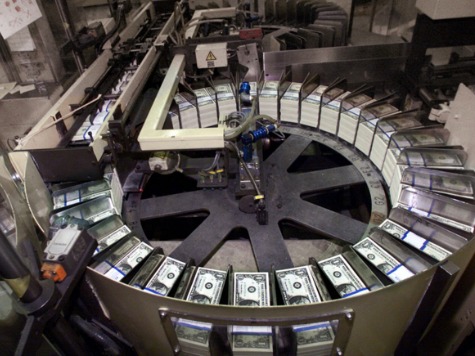
With the Federal Reserve beginning a two-day meeting to consider raising interest rates and strengthening the U.S. dollar, all hell broke out in financial markets as emerging-market stocks plummeted to a ten-month lows, the Russian ruble gyrated by 36% before trading was halted, and crude oil hit a low of $53.60.
Having cut interest rates for over a decade to weaken the U.S. dollar exchange rate in order to make American exports more competitive and foreign imports more expensive, rising inflation may force the Fed to reverse course and begin raising interest rates. Strong dollar periods in the 1980s and 1990s caused emerging market financial crisis. With the dollar appreciating, trillions in emerging market “dollar loans” may default.
Cheap money from the Fed pushing down the exchange rate of the dollar incentivized emerging markets to borrow $9.3 trillion in U.S. dollars. But with the Fed eliminating quantitative easing and other stimulus, the exchange rate of the dollar has been getting stronger, and the cost for foreign borrowers to pay back those “dollar loans” is spiking.
The cost for Russia to pay back dollar loans has already doubled this year. Falling oil prices, coupled with Western sanctions have slammed the Russian economy. When the Russian central bank spiked interest rates from 10.5% to 17% this week, the ruble strengthened by 10%. But waves of panic selling as banks tried to dump rubles sent the currency down for an intraday loss of -36%, before recovering for a -11% net loss. In economic terms, food imports to frozen Russia now cost 11% more than the day before.
From 2002 to 2012 the exchange rate of the U.S. dollar steadily declined by 38% as huge swaths of the American economy were outsourced to China and other emerging markets. Despite the Fed’s $5 trillion of bank liquidity offered to banks at virtually zero interest rates, U.S. industrial and real estate loan demand tanked.
But with foreign companies desperate for cash and willing to pay high interest rates to fund a ramp-up of exports to the U.S.; American banks, bond investors, and hedge funds loaned a record $2.3 trillion in U.S. dollars to foreign companies. Taking advantage of the trillions of dollars of Fed liquidity sloshing around in global money markets, foreign banks and bond investors lent another $7 trillion in “dollar loans” to foreign companies. The $9.3 trillion in foreign dollar loans exceeded the entire annual GDP of China.
Because foreign borrowers assumed that the United States’ competitiveness would continue to be crushed by cheap emerging market labor, they also expected to book a future profit when they paid off their loans with depreciated U.S. dollars.
But with the U.S. energy boom stimulating American economic competitiveness, the U.S. dollar has strengthened by 13% over the last two years and the Fed eliminated its stimulus. The stronger dollar means foreign companies, mostly in Asia, now owe another $1.2 trillion because of currency losses on top of the $9.3 trillion they borrowed!
The U.S. dollar appreciating by 51% in the early 1980s sparked the Latin American Debt Crisis. Mexico and most of South America were forced to default on about $327 billion in “dollar loans.” U.S.-based Citibank almost filed for bankruptcy and virtually every major U.S. bank became insolvent. The U.S. Treasury and IMF bailed out the Latin Nations and the American banks suffered a $67 billion loss.
With their economies growing by 8 to 12% of GDP per year in the 1990s, almost half of the total capital inflow during the decade went to dollar loans in East Asian developing countries. Foreign debt-to-GDP ratios in U.S. dollars rose from 100% to 180%. But as the dollar strengthened by 35%, the “Asian Flu” financial crisis caused Thailand, Philippines, Indonesia, Malaysia, and South Korea to default on $500 billion in debt. The IMF and World Bank had to provide over $100 billion in loans to restructure the debt.
Morgan Stanley worries that access to “cheap dollar loans” funded by the Federal Reserve caused the debt ratios in Asia to jump from 147% to an unsustainable 207% of GDP in the last six years. The appreciating U.S. dollar is squeezing Asian borrowers.
Most of the stress in emerging markets is related to only a 12% rise in the value of the dollar. But at the end of the U.S. Federal Reserve meeting this week, Chairman Yellen has scheduled a personal presentation of the “Summary of Economic Projections and a press conference by the Chair.” If the Fed indicates that U.S. interest rates are going to move up, currency and emerging markets are going to panic, and the dollar will strengthen by 35% to 51% and cause another financial wipeout.
If you are interested in financial issues and crony capitalism, please click on Banks Get OK to use Taxpayer Money for Derivative Speculation.

COMMENTS
Please let us know if you're having issues with commenting.